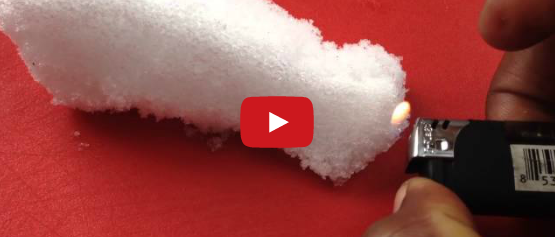Meteorologists Debunk the Viral 'IS THIS SNOW?
The internet exploded this week over a video of some very controversial snow that doesn't appear to melt when held to a lighter. The snow, which is shown being taken from a backyard in Michigan, never forms a puddle of water despite being exposed to a source of intense heat.
Both the ice cube and the snow melt when the flame is held to them. The difference between the two, however, is their water content.
An ice cube holds a significantly higher water content than a small pile of fluffy snow. Because the amount of melting ice condenses into more water, it takes longer to evaporate and, thus, forms a puddle.
The snow, however, has a significantly lower water content than the ice and therefore, condenses, becomes slushy and evaporates before ever pooling on the ground.
The pile of snow, in this instance, is comparable to a sponge, AccuWeather.com Expert Meteorologist Bob Larson said.
"If you take a good, absorbent sponge and place it over a small puddle of water, it will soak it up," he said. "If you look closely, you see the surrounding snow soak up water from the melting snow in his video."
Water content does vary between different types of snow. The higher the water content, the more water will be left behind as it melts.
If both the ice cube and the snow were left out to melt, without an intense source of heat, the snow would have also formed a puddle, Larson said.
To answer the videographer's question: Yes, unequivocally, the cold, white stuff that fell from the sky in Michigan is snow. The light, fluffy stuff just didn't have a high enough water content, when paired with extreme heat, to result in a puddle.
Source: Accu Weather
Though the creator of the video, among others, has linked the phenomenon to a chem trails conspiracy theory, there's a scientific reason for why the snow seemingly disappears, while an ice cube under the same conditions forms a puddle.
Both the ice cube and the snow melt when the flame is held to them. The difference between the two, however, is their water content.
An ice cube holds a significantly higher water content than a small pile of fluffy snow. Because the amount of melting ice condenses into more water, it takes longer to evaporate and, thus, forms a puddle.
The snow, however, has a significantly lower water content than the ice and therefore, condenses, becomes slushy and evaporates before ever pooling on the ground.
The pile of snow, in this instance, is comparable to a sponge, AccuWeather.com Expert Meteorologist Bob Larson said.
"If you take a good, absorbent sponge and place it over a small puddle of water, it will soak it up," he said. "If you look closely, you see the surrounding snow soak up water from the melting snow in his video."
Water content does vary between different types of snow. The higher the water content, the more water will be left behind as it melts.
If both the ice cube and the snow were left out to melt, without an intense source of heat, the snow would have also formed a puddle, Larson said.
To answer the videographer's question: Yes, unequivocally, the cold, white stuff that fell from the sky in Michigan is snow. The light, fluffy stuff just didn't have a high enough water content, when paired with extreme heat, to result in a puddle.
Source: Accu Weather
Related Posts:
- Evaporating Water in -30C. Must See!
- This Is What Happens When You Put Two Pounds Of Dry Ice In Hot Water. You're Going To Wish You Were In The Room When This Happens.
- Snow Roller: A Strange Meteorological Phenomenon
- I Had No Idea This Winter Phenomenon Even Happened. And Now I Can’t Stop Looking At It… Wow.
- Spectacular Photos of Bubbles Frozen in Frigid Temperatures
Meteorologists Debunk the Viral 'IS THIS SNOW?
 Reviewed by Truth Seeker
on
8:59 PM
Rating:
Reviewed by Truth Seeker
on
8:59 PM
Rating:
 Reviewed by Truth Seeker
on
8:59 PM
Rating:
Reviewed by Truth Seeker
on
8:59 PM
Rating:


+-+This+is+Alaska's+Muir+Glacier+&+Inlet+in+1895.+Get+Ready+to+Be+Shocked+When+You+See+What+it+Looks+Like+Now..jpg)




No comments